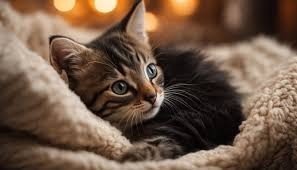
How to understand cat language?
Cats, our fuzzy companions, communicate through a unique and complex system based on non-verbal gestures, a variety of body language, and a range of different vocal expressions. Unraveling the mysteries around this silent language offers cat owners valuable insights into their temperaments, needs, and desires. In this exploration, we examine the fascinating world of feline communication, shedding light on the subtle and hidden ways in which cats express themselves.
Cats' speech and nonverbal messages can sometimes be confusing. Cats have been viewed for centuries as mysterious, aloof, and unpredictable creatures, perhaps because humans have difficulty understanding what they are saying. While humans rely primarily on speech to communicate, cats rely mostly on silent language. Cats speak using complex combinations of body language, vocal expressions, and scent signals. Learn how to recognize the basics of cat language, and gain an understanding of the most common constructions, to understand what your cat is saying to you and the other pets in your family.
You can buy products for your cat to play inside the house here
Types of communication in languages
Voice communication
Cats communicate with a variety of sounds to express their feelings and communicate with humans and other cats. Here are some common sounds and their possible meanings:
1. Meow:
- Meow is the most common sound, and can express a desire for food, play, or enjoyment of attention.
2. Ringing (gifting):
A chirping is a sound a cat makes to express happiness and contentment, and is usually accompanied by repetitive movements of the chin.
3. Whisper (warning):
- A whisper is a speed-like sound, made when a cat feels threatened or in danger.
4. Whistling (provocation):
- Whistling is issued when the cat is angry or about to attack, and may be accompanied by the ears being placed back.
5. Rejection (escape):
The sound that sounds like an escape is made when the cat is in an uncomfortable state or feels threatened, and expresses his desire to get away.
6. Growling (pain or wakefulness):
- The growl is issued when the cat feels pain or when he wakes up and feels confused.
Understanding these sounds can help you communicate effectively with your cat, meet his needs, and understand his feelings.
Cats use vocal expressions to express emotions. Whining, whispering, grunting, growling, venting, etc., are part of the cat's arsenal, and they all carry special meanings depending on the context in which they appear. While adult cats typically do not negotiate with each other using yowling, domesticated cats have learned to yow with humans. Some scientists believe that this is a strategic behavior adopted by cats to get what they want from their owners.
Speaking by ear
Cats have a special language that relies on ear movements, as they use these movements to express their feelings and intentions. Here are some signs that appear through ear movements:
Ears straight forward:
- A signal to pay attention and listen.
Ears straight back:
- It may mean anger or readiness to attack.
Single straight ear:
It may reflect a state of curiosity or concentration.
Rapidly moving ears:
- An indication of excitement or confusion.
Low-set ears:
- Usually indicates fear or surrender.
Swing ear:
- It may be a sign of comfort or happiness.
Cats' ears are an important way to express their emotional state and send certain messages. Shape, posture, and ear movements can be strong signs of what's going on in your cat's mind and emotions. Understanding cats' "ear language" is key to understanding their rich and complex communication. Learn about the signals that come from the ears and how you can understand what a cat is trying to tell you through the language of its ears.
Cats also express emotions and intent through their ears. Ears straight forward express
interest.
Generally, the more a cat's ears bend to the sides or back, the more stimulated or disoriented the cat will be. Ears that are bent back with a whine or tug are a clear sign that the cat feels threatened or does not like what you are doing.
Speak with eyes
Eyes are an important means of expression for cats, expressing feelings, emotional state, and intent. Here are some signs that a cat's eyes can show:
Attention look:
- Wide open eyes express alertness and interest.
Narrow eyes:
Narrow eyes may indicate comfort or confidence.
Closer look:
- Gazing eyes indicate scanning the environment or focusing on a specific object.
Sparkling eyes:
Shiny eyes may be a sign of enthusiasm or playfulness.
Low-set eyes:
- Reduced eyes that may express discomfort or fear.
Slow wink:
A slow wink is a sign of trust and affection.
Understanding cats' eye language can be key to understanding their emotional state and communicating effectively with them.
Cats communicate through their eyelids, i.e. how open or closed they are, as well as the expansion of the blue (the black part of the eye). A sudden expansion of the cyanosis (enlargement) is caused by a sudden emotion that can be caused by fear, interest, or another strong emotion. Eyes wide open express confidence, while eyes narrowed to a narrow slit can be a signal of fear or aggression. If your cat's eyes appear tired or sleepy, this is a sign that your cat is relaxed and confident. Try a slow wink and see if your cat responds with a wink as well, which is a "kitty kiss" as a sign of affection. But if your cat is staring at another cat without winking, this is a sign of dominance or aggression.
Tail language
Cats have a special language through the movements of their ears, and among these movements comes the “tail language” that expresses a variety of feelings and psychological states. Here are some cat tail language signals
Tail raised up:
- It expresses confidence and happiness.
Tail low or between the legs:
- It may indicate fear or mystery.
Tail falling:
- It may be a sign of rest and relaxation.
Tail swings from side to side:
- It may indicate enthusiasm or joy.
The tail moves quickly:
- It may be a sign of provocation or disturbance.
Tail touching others:
- When a cat touches others with its tail, this expresses friendliness and comfort.
Understanding the language of the tail helps you understand the cat's feelings and interact better with it. The context of movement and other interactions should always be considered to get a more accurate understanding of the cat's condition and feelings.
A cat's tail sends signals of interest, affection, provocation, and more. The height of the tail, as well as the movement, have special meanings. A cat raises its tail when it wants to get closer to you. This is a sign that interaction is welcomed. A tail that sways or flops is usually a signal to stay away. A tail that moves from side to side may be a sign of play or frustration. If the fur on the tail is wrinkled, it shows defense. When the tail is held high and curled, the cat is ready to fight. When it is hidden between the legs, the cat experiences extreme fear.
Fur language
Cats have a fur language that expresses a range of emotions and psychological states. Here are some signals that a cat fur can send:
Straight fur:
- Indicates relaxation and confidence.
Puffy fur:
- Puffy fur usually shows fear or alarm.
Disgusting fur:
- It can be a sign of readiness to attack or defend.
Raised fur:
Raised fur often appears when a cat feels hissing or stress.
Coordination with tail movement:
- When fur is associated with tail movements, these cues can enhance understanding of a cat's emotional state.
Excessive cleaning:
- Sometimes, a cat grooms its fur excessively as a reaction to stress or anxiety.
Understanding your cat's fur language helps you interact better with it and provide a comfortable environment. Although there are general rules, the overall context must always be considered to get an accurate understanding of the cat's condition and feelings.
A healthy, calm cat's fur remains soft and flat against the body. Cats are naturally self-cleaning animals, meaning the condition of their fur can reveal a lot about their health. Unruly fur can indicate health problems and should not be ignored, especially when accompanied by other symptoms such as fatigue or vomiting. However, suddenly puffy fur, including a tail that resembles a “bottle brush,” indicates fear or aggression. "It's best to stay away from a cat that shows this type of response."
You can always buy clothes for your cat to maintain its fur so that it is always healthy and it expresses itself easily. You can also always maintain your cat’s fur by using Petaholic care at a huge discount now.
Smell and smell
The senses of smell and scent play an essential role in cat communication. Cats have a superior sense of smell, and smell and odors are a major way for them to understand the environment and communicate with the world around them. Here are some important points about how cats react to smell:
Fragrance marks:
Cats leave scent marks by rubbing their face and mouth on objects and people. This is a way to express belonging and assert territory.
Individual scents:
Each cat has a unique individual scent that distinguishes it from others. Cats can recognize and identify each other through scent.
Recognizing the health condition:
Cats can smell changes in each other's body odor, which helps them determine their health status or changes.
Emotional communication:
Emotional feelings are expressed through certain smells, such as smells associated with comfort and security.
Reactions to odors:
Cats show specific reactions when exposed to certain smells, such as expressions of happiness or anxiety.
Skin's understanding of this close relationship between cats and scent can help build effective communication and foster a strong bond with pets.
Humans cannot always detect or interpret the scent signals that cats use to communicate. However, among the scent tools that cats use, they include strong marking using urine and feces for identification, rubbing behavior (rubbing against the body), and nail stripping to leave scent messages that are read by other cats.3 Cats have an earthy sense, and the scents they leave are clearly designed to send a message that says “ This territory is too 'mine' for potential intruders. Their sense of smell is so strong that newborn kittens use smell even before they can see things clearly.
body language
Cats use body language effectively to express their feelings and intentions. Here are some signals that cats send through body language:
Touch:
- - Gentle tentacle: expresses affection and desire for interaction.
- - Strong tentacle: This may be an attempt at identification or association.
Monitoring and grading:
- - Direct look with a slow wink: a sign of trust and affection.
- - Looking without winking: This may be a sign of dominance or willingness to challenge.
Physical positions:
- - The body is relaxed: it expresses comfort and confidence.
- - A tense body: may indicate readiness for defense or fear.
In concluding the exploration of cat language, the importance of building a strong relationship with cats through vigilant observation and response to their non-verbal signs must be emphasized. We have to acknowledge that every cat is unique, and understanding their individual preferences contributes to a deeper, more enriching relationship between humans and their feline friends. By examining deeply the silent language of cats, we open a door to a world where gestures speak louder than words, creating a harmonious and enriching connection between human and their feline friend.

